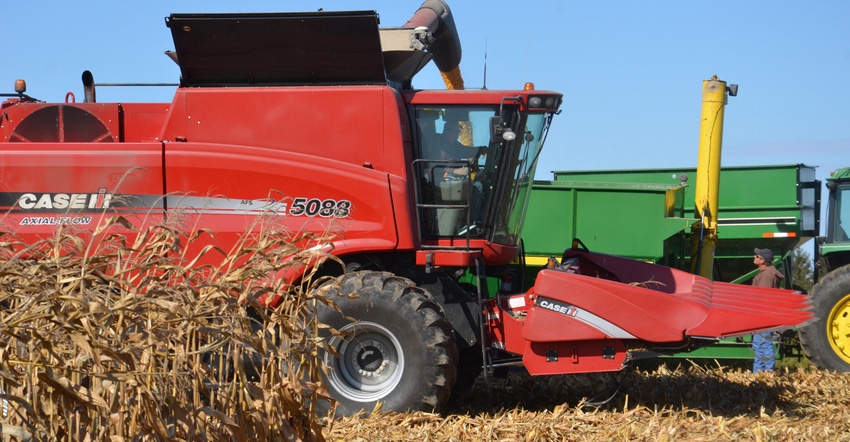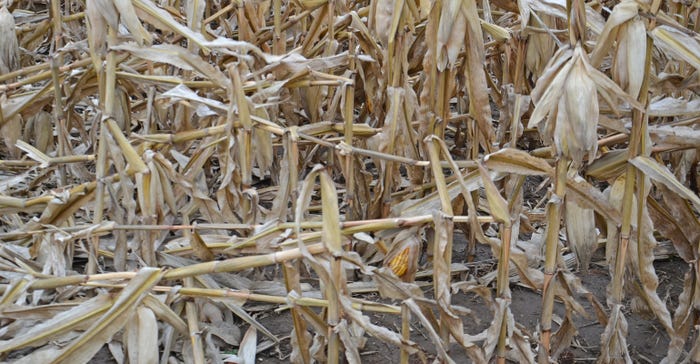
When is the ideal time to harvest corn? Should you start at 25% moisture and dry it? Start sooner? Start later? What are the risks of leaving corn in the field too long?
These issues have been addressed over the years, but minimal research has been devoted to these questions lately. In 2019, Indiana Prairie Farmer; Purdue University, through Bob Nielsen, Extension corn specialist; and the Throckmorton Purdue Agricultural Center near Romney, Ind., initiated a research trial to look at the trade-offs for harvesting at different times. The goal was to determine if fewer losses from harvesting at higher moisture contents offset higher drying costs for wetter corn.
Special thanks go to Beck’s for providing seed corn, and to Pete Illingworth and the farm crew at Throckmorton for handling planting and harvesting. Two hybrids were included in the trial, which was replicated four times. There were three harvest dates: late October, mid-November and early December.
Average moisture for the three harvest dates, combining both hybrids, was 24.4%, 21.5% and 20.8%, respectively. One hybrid tended to run a point or more wetter than the other hybrid at each harvest date.
Ideally, harvest would have started earlier in the fall, Nielsen notes. By late October, little field drying occurs in a normal year. “The 2019 season was so unusual that lots of corn didn’t reach black layer until late September or early October,” Nielsen recalls.
That applied to this field, too. It was planted June 1, but later-planted corn didn’t mature faster than if planted earlier, as it does in most other years.
Invisible yield loss
Yields were in the 200-bushel-per-acre range. When corrected to 15.5% moisture, there was virtually little difference between yields for the October and November harvests.
“There certainly wasn’t any invisible yield loss in the 2019 trial in either hybrid,” Nielsen says. Invisible yield loss refers to a loss in yield believed to be caused when respiration of kernels continues as corn dries in the field. If it exists, the same corn harvested a month later should yield less when corrected to 15.5% moisture because of losses of weight in the grain itself, no matter what happens with lodging and field loss.
The idea of potential invisible yield loss surfaced in the 1990s. Nielsen has looked at the concept in trials before. He reports seeing it occur in some cases, but not others. “It’s not been consistent, and it’s very hard to pin down,” he says.
Others contend it’s a real effect, but searching published reports, it doesn’t appear to show up consistently. Anecdotal evidence from farmers still indicates some believe it happens. It could be related to specific hybrids or environmental conditions, Nielsen says.
True field loss
What the 2019 study did indicate was that if you leave corn in the field too long, stalk lodging will eventually catch up with the corn, increasing harvest losses. In the 2019 study, this didn’t happen until early December.
Lodging was slightly higher in November than October, but it was negligible in both cases. It averaged only 0.5% in October and 2.0% in November — both very low, insignificant numbers. Total harvest loss was less than 1 bushel per acre for both the October and November harvests, counting corn shelled at the head, corn lost behind the machine and whole ears left in the field.
“That’s a very minimal amount of loss, but it’s not surprising in this case,” Nielsen says. “The field crew at the Throckmorton Ag Center does an excellent job of prepping the combine before harvest and maintaining it during harvest.”
Corn was harvested with a Case IH combine with a six-row corn head. Both are about 5 years old.
Minimal loss in November is even more amazing considering several inches of snow fell before the November harvest date, with some still lingering on the ground during harvest. In fact, total losses were lowest for the mid-November harvest, averaging under half a bushel per acre.
Why? One theory is that since plants were tougher after the snow, there was less shelling at the head. Lower numbers for losses due to random kernels found after each pass would seem to back up that theory.
“December was a different story, however,” Nielsen says. Illingworth reported a strong windstorm around Thanksgiving. Stalks finally succumbed. Lodging was significantly higher, at just under 40%. Field loss was also significantly higher, at just under 3.5 bushels per acre. Most of the field loss came from whole ears left behind in the field, typically on lodged stalks.

WAITING TOO LONG: It took a Thanksgiving storm to take this corn down in 2019. Plots in this trial harvested in October and November showed almost no lodging.

“Note that average moisture only dropped less than a point from the November to December harvest,” Nielsen observes. “You get very little field drying very late in the fall. Yet you run increased risk of major field losses.”
Drying costs
The question of when you should start harvest may be the most difficult to answer. Even if you discount invisible losses due to respiration, eventually, losses due to lodging, greater shelling at the head, wildlife and more kick in.
There are two big variables that only you can answer:
How much do you pay for propane?
How efficient is your dryer?
Drying industry experts note that while $1 per gallon may be an average price for propane, some growers likely pay considerably more and some considerably less, depending upon volume discounts and other factors.
Determine drying costs for the moisture percentage where you would like to start harvest using your numbers, Nielsen suggests. “Obviously, based on this one trial, it didn’t pay to harvest in October and remove an extra 3 points of moisture versus November,” he says. “It did pay versus waiting until December.
“The problem is, you never know when a big storm or stalk diseases will take their toll and result in higher machine losses. Every harvest won’t be like 2019. You need to make an informed decision.”
About the Author(s)
You May Also Like




